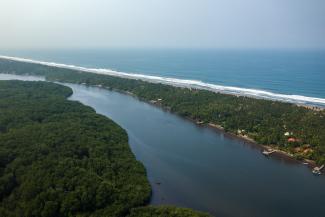The United States Agency for International Development (USAID) and its partner the International Union for Conservation of Nature (IUCN) presented the achievements of the Regional Coastal Biodiversity Project in Barra de Santiago, Ahuachapán, El Salvador, one of the project implementation sites.
During seven years, the project generated environmental, economic and social benefits in ecosystems and marine-coastal communities in border sites of high biodiversity in Guatemala, El Salvador and Honduras, to help reduce threats to biodiversity and create economic prosperity and rootedness in the territories.
With a total investment of more than $13 million from USAID, IUCN implemented the project in consortium with GOAL International, as a regional partner, and IUCN member organizations Salvadoran Ecological Unit (UNES), the Moskitia Development Agency (MOPAWI), Defenders of Nature Foundation (FDN) and Association for the Rescue of Wildlife (ARCAS).
The main results include improving the livelihoods of 3,941 people in marine-coastal communities in the three countries, generating $1,854,254 in sales through 26 entrepreneurial projects in fishing, tourism and mangrove-linked beekeeping. Through its Small Grants Program, the project provided technical and financial support to the entrepreneurial projects under a biocommerce approach. Thus, 12 entrepreneurial projects integrated the production of renewable energy with an installed capacity of 66.4 KW, as a measure to adapt to climate change.
In addition, the project led to improved natural resource management in 565,689 hectares of biologically important coastal-marine landscapes, including 79,739 hectares with improvements in water flow, species protection, ecosystem connectivity and carbon sequestration. At least 285 people linked to these landscapes strengthened their skills and capacities for climate change adaptation.
As part of the activities, workshops for evidence-based biodiversity conservation were also held with the participation of 1,498 residents of the communities who now have the knowledge for sustainable natural resource management. In addition, the project concluded the analysis of data and evidence, two scientific articles, six technical proposals for resource management, documents with information based on research and monitoring of five species of commercial interest associated with three key ecosystems for conservation (mangroves, reefs and seagrasses).
The regional event was attended by the Minister of Environment and Natural Resources of El Salvador, Fernando Lopez; the Acting Director of USAID El Salvador, Matt Rees; the Undersecretary of Livestock and representative of the Pro Tempore Presidency of the Organization of the Fisheries and Aquaculture Sector of the Central American Isthmus (OSPESCA), José Acosta; the Regional Executive Secretary of SICA-OSPESCA, José Infante; the representative of the Ministry of Environment and Natural Resources (MARN) of Guatemala, Mario Díaz; and the representative of the IUCN Regional Directorate, Raquel Sigüenza.

USAID El Salvador
